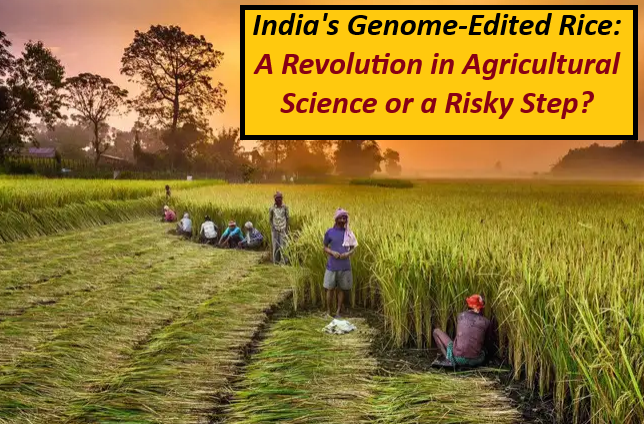
India has launched its first genome-edited rice varieties—DRR Dhan 100 and Pusa DST Rice 1—aiming to boost yield and climate resilience. But does this scientific leap come with hidden risks? This blog explores the science, safety, ethics, and policy implications of genome editing in Indian agriculture. भारत ने उपज और जलवायु लचीलेपन को बढ़ावा देने के उद्देश्य से अपनी पहली जीनोम-संपादित चावल की किस्में-डीआरआर धन 100 और पूसा डीएसटी चावल 1 लॉन्च की हैं। लेकिन क्या यह वैज्ञानिक छलांग छुपे जोखिमों के साथ आती है? यह ब्लॉग भारतीय कृषि में जीनोम संपादन के विज्ञान, सुरक्षा, नैतिकता और नीतिगत निहितार्थों की पड़ताल करता है।
India's Genome-Edited Rice: A Revolution in Agricultural Science or a Risky Step?
India has taken a bold leap in agricultural innovation by releasing two genome-edited rice varieties: DRR Dhan 100 (Kamala) and Pusa DST Rice 1. Developed by premier research institutions under ICAR – namely IARI (New Delhi) and IIRR (Hyderabad) – these rice varieties are designed to combat environmental challenges like drought and salinity while increasing yield.
This move promises food security and better income for farmers, but it also raises a debate around biosafety, ethics, and long-term implications.
Genome editing is a method that allows scientists to make targeted changes to an organism's DNA without inserting foreign genes. The tool used in this case is CRISPR-Cas9, which works like molecular scissors.
Genome Editing: Precise edits in existing genes (no foreign DNA involved).
Genetic Modification: Involves inserting foreign DNA (transgenic).
These edited crops are often non-transgenic, which makes regulatory approval easier in many countries.
Developed by: ICAR-IIRR, Hyderabad
Parent variety: Samba Mahsuri (BPT-5204)
Key traits:
High yield
Drought and salinity resistance
Better grain quality
Developed by: ICAR-IARI, New Delhi
Parent variety: Cotton Dora Sannalu (MTU 1010)
Key traits:
Enhanced DST gene for drought/salt stress
Ideal for climate-challenged regions
These traits were introduced using SDN-1 and SDN-2 genome editing techniques.
Climate Resilience: India is increasingly facing droughts, salinity, and erratic monsoons. These varieties are built to withstand such stress.
Higher Yield: With improved genetics, these rice plants promise better output per hectare.
Faster Breeding: Genome editing reduces the breeding cycle significantly compared to traditional methods.
Food Security: Rice is a staple for millions. Stable rice production = stable food supply.
Environmental Impact: Stress-resistant varieties reduce the need for excessive irrigation and chemical inputs.
The launch was met with resistance from some civil society groups like the Coalition for GM-Free India. Their key concerns:
CRISPR is not entirely precise. Unintended genetic changes may occur.
Long-term health and environmental impacts are not fully known.
Regulatory shortcuts might compromise biosafety.
ICAR scientists assert that SDN-1/2 edits mimic natural mutations.
Over 30 countries (including USA, Japan, Argentina) have exempted these techniques from strict GM regulations.
India's 2022 guidelines have also notified exemptions for genome-edited plants not containing foreign DNA.
Should we focus on better distribution instead of better production?
Are corporate seed monopolies a risk with genome-edited seeds?
How do we ensure farmer autonomy and informed consent?
Can public institutions safeguard public interest in such tech?
Transparent Regulation: Update and strengthen the biosafety framework.
Public Awareness: Educate farmers and citizens about genome editing.
Ethical Oversight: Include ethicists and sociologists in policy-making.
Inclusive R&D: Focus on millets, pulses, and regional crops too.
International Alignment: Coordinate with global agencies on safety norms.
India’s genome-edited rice is a double-edged sword. It represents:
A scientific breakthrough in precision agriculture.
A governance challenge in biosafety and public engagement.
An opportunity for Atmanirbhar Bharat in agricultural innovation.
Its success will depend on transparent policies, science-driven regulation, and trust-building among stakeholders.
Q1. What genome editing tool was used to develop India’s new rice varieties?
A) TALENs
B) CRISPR-Cas9
C) ZFN
D) RNAi
✅ Answer: B) CRISPR-Cas9
Q2. DRR Dhan 100 is derived from which parent variety?
A) MTU 1010
B) IR-64
C) Samba Mahsuri (BPT-5204)
D) Pusa Basmati
✅ Answer: C) Samba Mahsuri (BPT-5204)
Q3. What do SDN-1 and SDN-2 refer to in genome editing?
A) Types of rice pests
B) Editing tools that insert foreign DNA
C) Site-directed mutation methods
D) Soil nutrients
✅ Answer: C) Site-directed mutation methods
Q4. Which of the following is true about genome-edited crops in India?
A) They contain foreign DNA
B) They are strictly banned
C) They were notified for exemption under GM regulations in 2022
D) They are same as traditional GM crops
✅ Answer: C) They were notified for exemption under GM regulations in 2022
"Genome editing in agriculture is a scientific boon with social obligations." Discuss the opportunities and challenges associated with genome-edited crops in India.
Examine the role of public research institutions like ICAR in promoting ethical, inclusive, and sustainable agricultural biotechnology.
"Technology alone is not the solution; policy and perception matter equally." Evaluate this statement in the context of India's genome-edited rice initiative.
India’s genome-edited rice is not just a scientific achievement, but a test case for responsible innovation. It holds promise for climate-resilient agriculture and better food security, but it also demands careful regulation, ethical clarity, and public confidence.
11-Jul-2025 02:29 PM
Explore the fascinating structure, origin, and dynamics of our Earth—from...
11-Jul-2025 02:18 PM
Understand the vital role of lysosomes and cellular transmission in...
11-Jul-2025 01:48 PM
A concise and exam-focused overview of Plasmolysis and Protoplasm, covering...
04-Jul-2025 12:46 PM
India’s education system is undergoing a major transformation to prepare...
02-Jul-2025 02:51 PM
Recent research suggests that the transfer of genes between fungi...
07-Jun-2025 03:32 PM
SKUAST-Kashmir has created India’s first gene-edited sheep using CRISPR-Cas9, targeting...
07-Jun-2025 05:39 PM
India has added four new wetlands to the Ramsar list,...
Leave a Comment